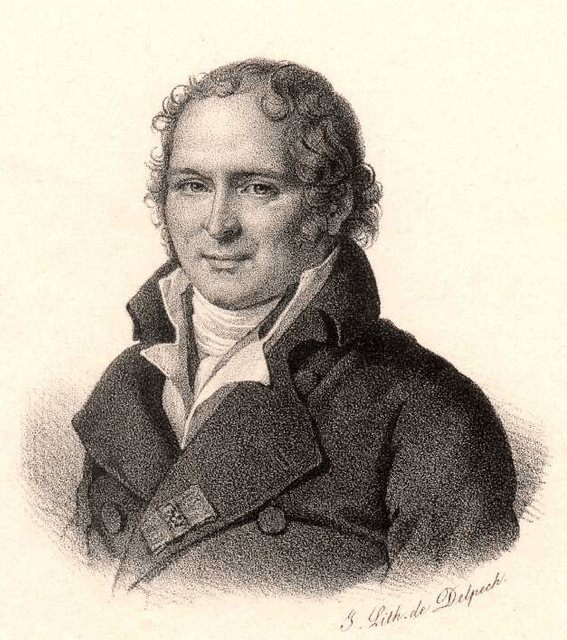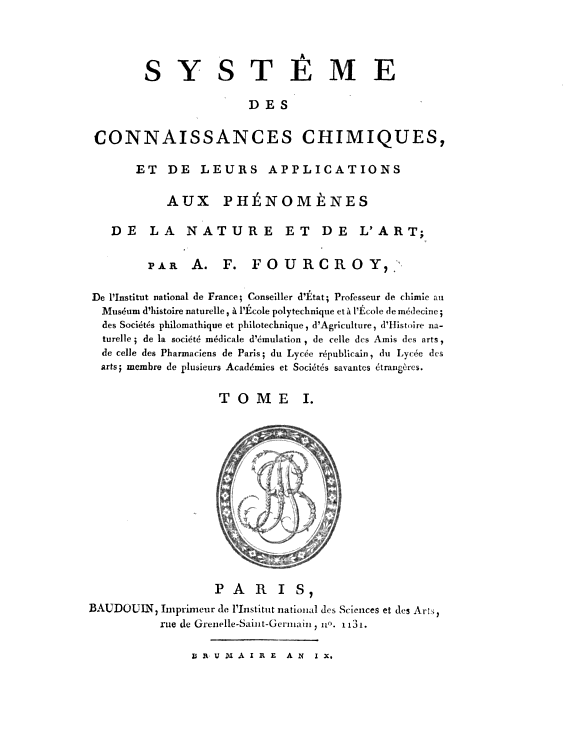Antoine François, comte de Fourcroy

Antoine François, comte de Fourcroy

Antoine François, comte de Fourcroy | |
|---|---|
| Born | (1755-06-15)15 June 1755 Paris |
| Died | 16 December 1809(1809-12-16)(aged 54) Paris |
| Nationality | French |
| Citizenship | French |
| Known for | Co-discovered Iridium Co-founded modern chemical nomenclature |
| Scientific career | |
| Fields | chemistry |
| Doctoral advisor | Jean Baptiste Michel Bucquet |
| Doctoral students | Louis Nicolas Vauquelin |
Antoine François, comte de Fourcroy (15 June 1755 – 16 December 1809) was a French chemist and a contemporary of Antoine Lavoisier. Fourcroy collaborated with Lavoisier, Guyton de Morveau, and Claude Berthollet on the Méthode de nomenclature chimique, a work that helped standardize chemical nomenclature.
Antoine François, comte de Fourcroy | |
|---|---|
| Born | (1755-06-15)15 June 1755 Paris |
| Died | 16 December 1809(1809-12-16)(aged 54) Paris |
| Nationality | French |
| Citizenship | French |
| Known for | Co-discovered Iridium Co-founded modern chemical nomenclature |
| Scientific career | |
| Fields | chemistry |
| Doctoral advisor | Jean Baptiste Michel Bucquet |
| Doctoral students | Louis Nicolas Vauquelin |
Life and work

Last work published by Foucroy before his death, the "Système des connaissances chimiques et de leurs applications aux phénomènes de la nature et de l'art", 1801.
Fourcroy was born in Paris, the son of an apothecary in the household of the Duke of Orléans. On the advice of the anatomist Félix Vicq-d'Azyr (1748–1794) he took up medical studies, and after many difficulties caused by lack of means he finally obtained his doctor's diploma in 1780. He taught chemistry from (1783–1787) at the Veterinary School of Alfort.[1] Fourcroy's attention was turned specifically to chemistry by J. B. M. Bucquet (1746–1780), the professor of chemistry at the Medical School of Paris. In 1784 Fourcroy was chosen to succeed P. J. Macquer (1718–1784) as lecturer in chemistry at the college of the Jardin du Roi, where his lectures attained great popularity.[2]
Fourcroy was one of the earliest converts to the views of Lavoisier, which he helped to make widely known by his own voluminous writings.[2] The Royal Society's Catalogue of Scientific Papers enumerates fifty-nine memoirs by Fourcroy alone, and fifty-eight written with others, mostly Louis Nicolas Vauquelin. Fourcroy's 1785 publication, Entomologia Parisiensis, sive, Catalogus insectorum quae in agro Parisiensi reperiuntur ..., co-written with Étienne Louis Geoffroy, was a major contribution to systematic entomology.
Although Fourcroy's name appears on a large number of chemical and also physiological and pathological memoirs, he was as much a teacher and an organizer as an original investigator.[2] As a member of the Committees of Public Safety and Public Instruction in the Convention, Fourcroy also had a prominent role in developing law that would affect medical education in France.[3] Fourcroy collaborated with physician Francois Chaussier to create a report that would be the basis of the Law of 1794, which integrated medicine and surgery and established health schools that taught both of these fields to all students.[4] Prior to this law, medical education was heterogeneous throughout France, with several different colleges and universities operating under varying standards. The law pushed by Fourcroy unified the French medical education system under centralized authority, and led to the issuing of national licensing years later.[5]
Later with Vauquelin, he identified a metal in a platinum residue they called ‘ptène’.This name ‘ptene’ or ‘ptène’ was reported as an early synonym for osmium.[6]
Awards and honours
In 1801, Fourcroy was elected a foreign member of the Royal Swedish Academy of Sciences.
On December 16, 1809, the very day on which he died in Paris, Fourcroy was created a count of the French empire.[2] He is buried in the Père-Lachaise Cemetery in Paris.
Antoine-François de Fourcroy's 1787 publication entitled Méthode de Nomenclature Chimique, published with colleagues Antoine Lavoisier, Claude Louis Berthollet, and Louis Bernard Guyton de Morveau,[7] was honored by a Citation for Chemical Breakthrough Award from the Division of History of Chemistry of the American Chemical Society, presented at the Académie des Sciences (Paris) in 2015.[8][9]
It is believed that Cape Fourcroy, at the western tip of Bathurst Island, Northern Territory, Australia, is named after Fourcroy. The cape was named during Baudin's expedition to Australia, and it is known that Baudin had a copy of one of Fourcroy's texts with him on the Géographe.[10]
Controversy
By his conduct as a member of the Convention, Fourcroy has been accused of contributing to Lavoisier's death. Baron Cuvier, in his Eloge historique of Fourcroy, repelled such charges. According to the Encyclopædia Britannica Eleventh Edition: although active, though secret, participation cannot be proved against Fourcroy, "he can scarcely be acquitted of time-serving indifference."[2] See the works in the Bibliography below for other opinions.